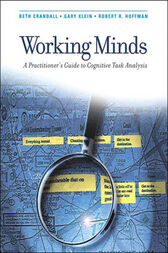
Authors: Beth Crandall, Gary Klein, and Robert Hoffman
MIT Press, 2006
Reviewed by Laura Militello (CEO at Applied Decision Science, and VP Research at Unveil)

Working Minds: A practitioners’ guide to cognitive task analysis is an important resource for anyone who uses cognitive task analysis methods
Beth Crandall, Gary Klein, and Robert Hoffman have all been involved in exploring strategies for eliciting tacit knowledge, analyzing qualitative data, and representing knowledge since the early days of cognitive task analysis. They have helped create and define this set of methods. The authors have tried different interview and observation strategies, and tailored analysis and representation strategies for domains as varied as weather forecasting, critical care nursing, and software debugging. In this book, they share with readers the strategies they have found useful for planning and implementing a cognitive task analysis project that will create the conditions needed for discovery and insight.
Working Minds is a practical guide to studying cognition in real-world contexts and professional practice at work. This is not a theoretical volume. Rather, the authors share specific “how to” guidance based on their own experiences conducting cognitive task analysis. They begin with preparation and framing, a critical part of the process that is often overlooked but can have important implications for the success of the project. They encourage readers to consider project goals and deliverables as means to sharpen research questions; to identify constraints that may influence who and how many people will participate in interviews; and to articulate the aspects of expertise, types of cognition, and situations that will best inform the research question and project goals.
With regard to knowledge elicitation, Working Minds covers concept maps as a strategy for eliciting and representing how people organize information including the connections they make between different concepts. The authors discuss incident-based techniques such as the widely-used Critical Decision Method, and strategies for using experiment-like tasks for knowledge elicitation. One of the most important chapters of this book is on analysis and representation. Analyzing qualitative data and creating effective representations tailored to project goals is where the magic occurs in cognitive task analysis. This requires judgement and creativity balanced with scientific rigor. Few have gone to the effort to unpack this part of the process as these authors have.
In the spirit of full disclosure, I should mention that I have worked with and long admired the contributions of these authors. That said, I highly recommend this book for anyone who wants to know more about cognitive task analysis. Whether you are just learning cognitive task analysis or have been using these methods for some time, you will enjoy how Crandall, Klein, and Hoffman reflect on their own experiences and share their insights about how to study cognition in real-world contexts.
For other opportunities to learn about cognitive task analysis, visit the CTA Institute at https://cta.institute.
You may also be interested in Working Mind’s sister book, Perspectives on Cognitive Task Analysis: Historical origins and modern communities of practice, covering more theoretical issues.
